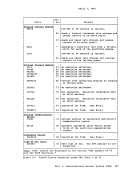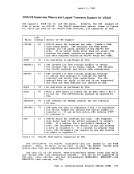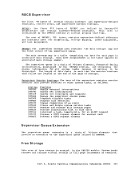virtual machine is still run in dynamic address translation mode, but
since the virtual page address is the same as the real page address, noccw translation is required. Since CCW translation is not performed, no
check is made to ensure thatI/O data transfer does not occur into page
zero or any page beyond the end of the virtual=real machine's storage.Systems that are generated
system loader(DMKLDOOE). virtual=real system, see the
For information about generating a
virtual=real option.
example of a real storage layout with
TheV=R area is 128K and real storage is 512K. Virtual Storage Addresses I CP PAGE 0 (MODULE DMKPSA) 4KI I Virtual Page 1 I I VIRTUAL=REAL AREA
/
/SIZE = 128K BYTES I (Minimum size is 32K bytes.) 128KI OKI Virtual Page 4K, 132K, / REMAINDER OF CP NUCLEUS / , I I / DYNAMIC PAGING AREA
/ andI FREE STORAGE I I I I I I /
/, I 0 I I I /
/I I I /
/I Real Storage Addresses OK 4K 128K
132K(DI1KSLC) End of CP Nucleus (DMKCPE) 512K (End of real
storage)
Figure 13.Storage Layout in a Virtual=Real Machine the
There are several considerations for the virtual=real option that
affect overall system operation:
1. The area of contiguous storage built for the virtual=real machine
must be large enough to contain the entire addressing space of the
largest virtual=real machine. The virtual=real storage size that aVM/370 system allows is defined during system generation when the
option is selected.
2. The storage reserved for the virtual=real machine can only be used
by a virtual machine with that option specified in theVM/370 directory_ It is not available to other users for paging space, nor
forVM/370 usage until released from virtual=real status by a
system operator via theCP UNLOCK command. Once released, VM/370 must be loaded again before the virtual=real option can become
active again.96 Systeill
since the virtual page address is the same as the real page address, no
check is made to ensure that
zero or any page beyond the end of the virtual=real machine's storage.
system loader
For information about generating a
virtual=real option.
example of a real storage layout with
The
/
/
/ and
/
/
/
132K
storage)
Figure 13.
There are several considerations for the virtual=real option that
affect overall system operation:
1. The area of contiguous storage built for the virtual=real machine
must be large enough to contain the entire addressing space of the
largest virtual=real machine. The virtual=real storage size that a
option is selected.
2. The storage reserved for the virtual=real machine can only be used
by a virtual machine with that option specified in the
for
system operator via the
active again.















































































































































































































































































































































































































































